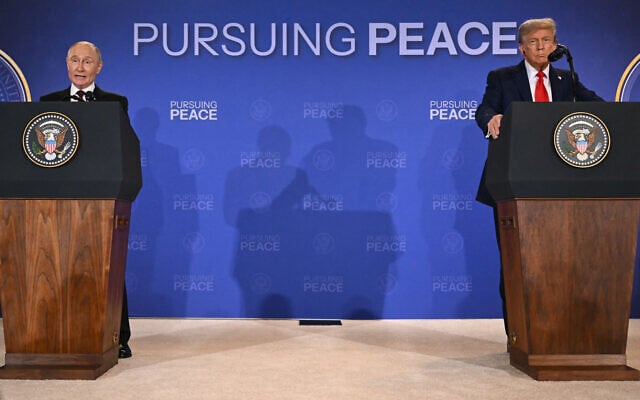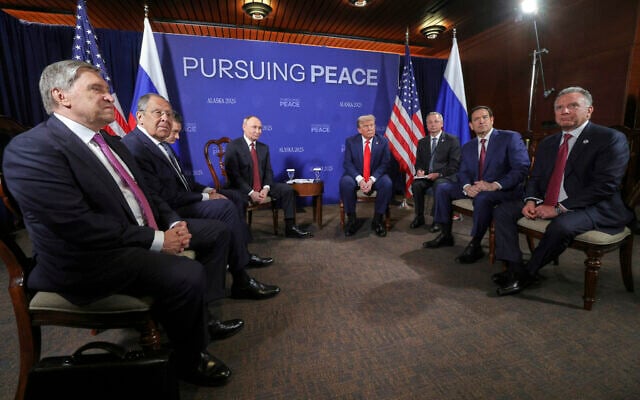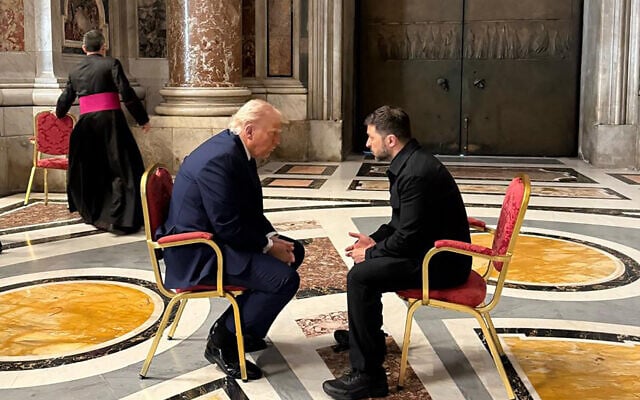



ANCHORAGE, Alaska (REUTERS) — A highly anticipated summit between US President Donald Trump and Russian President Vladimir Putin on Friday yielded no agreement to resolve or pause Moscow’s war in Ukraine, despite both leaders describing the talks in Alaska as productive.
During a brief appearance before the media following the nearly three-hour talks, the two leaders said they had made progress on unspecified issues. But they offered no details and took no questions, with the normally loquacious Trump ignoring shouted questions from reporters.
“There were many, many points that we agreed on. I would say a couple of big ones that we haven’t quite got there, but we’ve made some headway,” Trump said, standing in front of a backdrop that read, “Pursuing Peace.”
“There’s no deal until there’s a deal,” he added.
The talks did not initially appear to have produced meaningful steps toward a ceasefire in the deadliest conflict in Europe in 80 years — or toward a subsequent meeting between Putin and Ukrainian President Volodymyr Zelensky, both goals Trump had set ahead of the summit.
Putin said he expected Ukraine and its European allies to accept the results of the US-Russia negotiation constructively and not try to “disrupt the emerging progress.”
“I expect that today’s agreements will become a reference point, not only for solving the Ukrainian problem, but will also launch the restoration of business-like, pragmatic relations between Russia and the United States,” Putin said.
But Putin also repeated Moscow’s long-held position that what Russia claims to be the “root causes” of the conflict must be eliminated to reach a long-term peace, a sign he remains resistant to a ceasefire.
As the two leaders were talking, the war raged on, with most eastern Ukrainian regions under air raid alerts. Governors of Russia’s Rostov and Bryansk regions reported that some of their territories were under Ukrainian drone attacks.
Zelensky has ruled out formally handing Moscow any territory and is also seeking a security guarantee backed by the United States. Trump said he would call Zelensky and NATO leaders to update them on the Alaska talks.
There was no immediate reaction from Kyiv to the summit. Ukraine’s opposition lawmaker Oleksiy Honcharenko said on the Telegram messaging app, “It seems Putin has bought himself more time. No ceasefire or de-escalation has been agreed upon.”
Czech Foreign Minister Jan Lipavsky said in a statement that he welcomed Trump’s efforts but doubted Putin’s interest in a deal.
“If Putin were serious about negotiating peace, he would not have been attacking Ukraine all day today,” he said.
The anticlimactic end to the closely watched summit was in stark contrast to the pomp and circumstance with which it began. When Putin arrived at an Air Force base in Alaska, a red carpet awaited him, where Trump greeted Putin warmly as US military aircraft flew overhead.
For Putin, the summit — the first between him and a US president since Russia’s full-scale invasion of Ukraine in 2022 — was already a big win, regardless of its outcome. He can portray the meeting as evidence that years of Western attempts to isolate Russia have unravelled and that Moscow is retaking its rightful place at the high table of international diplomacy.
Trump hopes a truce in the 3-1/2-year-old war that Putin started will bring peace to the region as well as bolster his credentials as a global peacemaker worthy of the Nobel Peace Prize.
Putin is wanted by the International Criminal Court, accused of the war crime of deporting hundreds of children from Ukraine. Russia denies the allegations, and the Kremlin has dismissed the ICC warrant as null and void. Russia and the United States are not members of the court.
Both Moscow and Kyiv deny targeting civilians in the war. But thousands of civilians have died in the conflict, the vast majority Ukrainian, and the war has killed or injured well over a million people from both sides.
Trump and Putin, along with top foreign-policy aides, conferred in a room at an Air Force base in Anchorage, Alaska in their first meeting since 2019.
Zelensky, who was not invited to the summit, and his European allies had feared Trump might sell out Ukraine by essentially freezing the conflict and recognizing — if only informally — Russian control over one-fifth of Ukraine.
Trump had sought to assuage such concerns on Friday ahead of the talks, saying he would let Ukraine decide on any possible territorial concessions.
“I’m not here to negotiate for Ukraine, I’m here to get them at a table,” he said.
Asked what would make the meeting a success, he told reporters: “I want to see a ceasefire rapidly … I’m not going to be happy if it’s not today … I want the killing to stop.”
The meeting also included US Secretary of State Marco Rubio; Trump’s special envoy to Russia, Steve Witkoff; Russian foreign policy aide Yury Ushakov; and Foreign Minister Sergei Lavrov.
Trump, who once said he would end Russia’s war in Ukraine within 24 hours, conceded on Thursday it had proven a tougher task than he had expected. He had said if Friday’s talks went well, quickly arranging a second, three-way summit with Zelensky would be more important than his encounter with Putin.
Zelensky said ahead of Friday’s summit that the meeting should open the way for a “just peace” and three-way talks that included him, but added that Russia was continuing to wage war.
“It’s time to end the war, and the necessary steps must be taken by Russia. We are counting on America,” Zelensky wrote on Telegram.



